The AMD Kabini Review: A4-5000 APU Tested
by Jarred Walton on May 23, 2013 12:00 AM ESTKabini Windows 8 Laptop Performance
With the SoC and “lighter device” benchmarks out of the way, let’s also look at what Kabini offers for a full laptop experience. Let me preface this section by simply stating many of our laptop benchmarks really aren’t a good fit for an APU like Kabini—e.g. doing 3D rendering or x264 HD encoding on such a chip is just asking for poor performance. We’re also looking at different OS configurations (Windows 7 vs. Windows 8, IE8/9 vs. IE10), so there’s a slightly higher potential for margin of error here.
Our current list of laptops includes AMD's Brazos E-350 (MSI X370), Kabini A4-5000, and Trinity A10-4600M; on the Intel front we have i7-3517U (Dell XPS 12) and Pentium 2020M (a late addition when we managed to get a laptop for short-term testing). Both of the Intel chips are 22nm parts, but note that the Pentium chip is a 35W part. Sadly, we have not yet been able to get a Pentium 2117U as a comparison. [Note: Some laptops are still being tested on some of the benchmarks; their scores will be added/updated as they complete.]
We do want to see what sort of gains are present relative to Brazos, however, so let’s get started. We’re presenting an abbreviated look at performance here, but we have the full set of benchmark results in Mobile Bench, including some of our older benchmarks that we’ve run against Brazos and other laptops prior to 2013. There are two main questions to consider for each benchmark: how much faster is Kabini than Brazos (and where does it place relative to other options), and does Kabini provide enough performance to handle the task represented by the benchmark?
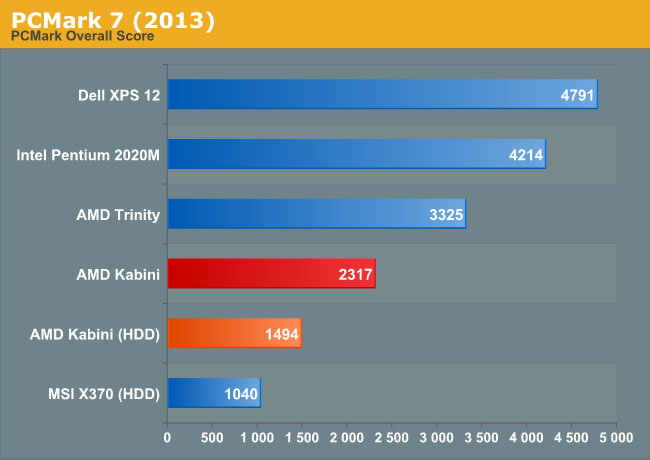
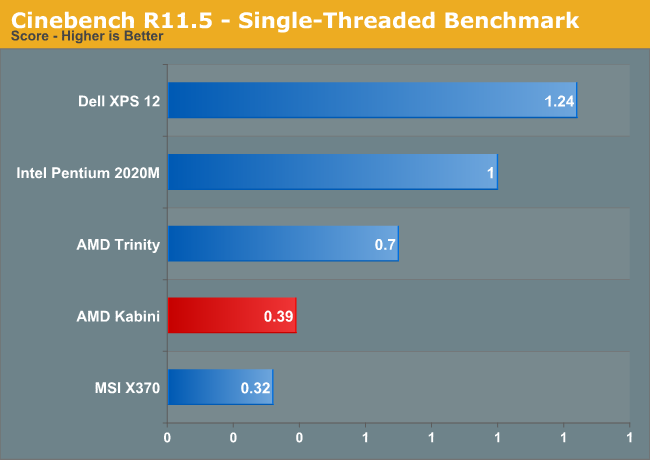
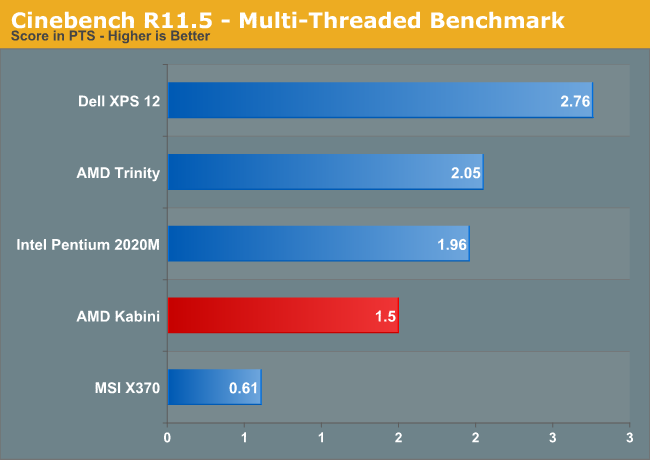
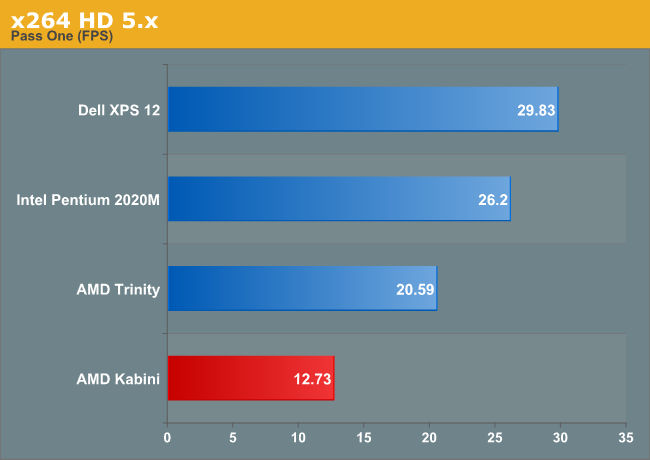
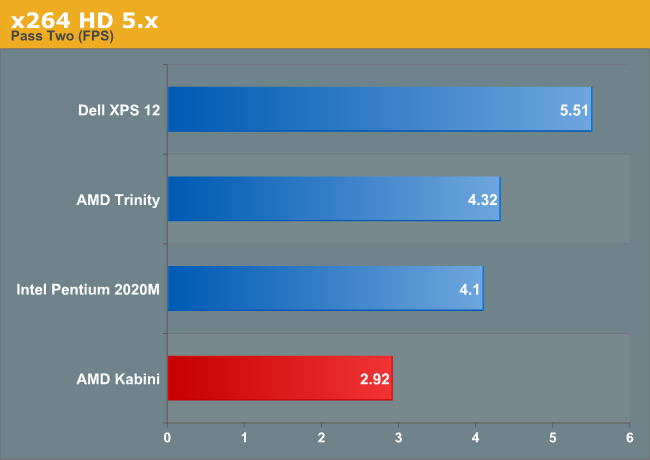
Starting with PCMark 7, we have both HDD and SSD results. As usual, the presence of an SSD boosts performance in the overall score by more than 50%, so Kabini with an SSD can feel far more responsive than Ivy Bridge with an HDD, depending on the task. Relative to Brazos, even with an HDD on both laptops, Kabini is nearly 50% faster. ULV Ivy Bridge on the other hand offers twice the performance of Kabini in the overall score, though Quick Sync skews that pretty heavily. Looking at the individual results, ULV IVB is around 30-50% faster on most CPU tasks, and it’s even a bit faster on the GPU side in most areas as we’ll see in a moment.
Update: We've added Pentium 2020M to the above charts, which lacks Quick Sync support and runs at a maximum clock speed of 1.8GHz. It's clearly slower than the i7-3517U in the Dell XPS 12, but it's also still a healthy step up from Kabini in terms of performance. The 2020M is a full 35W part, like the A10-4600M, and it tends to slightly outperform Trinity on CPU tasks while trailing in GPU performance. On the Kabini front, however, even the Pentium 2020M is able to lead on nearly all the performance metrics.
The CPU performance testing of x264 HD 5.x and Cinebench confirm the CPU deficit AMD faces with Kabini. In heavily threaded workloads, Ivy Bridge ULV is 50-100% faster, but the real problem is in the single-threaded workloads. A single Jaguar core in Cinebench manages to score just 0.39 compared to IVB ULV’s score of 1.24, so worst-case Kabini is one third the speed of Ivy Bridge. Standard Voltage Trinity APUs are likewise a big step up from Kabini, offering roughly twice the CPU performance in some cases. Of course, the power draw from standard Trinity tends to be far higher than Kabini.

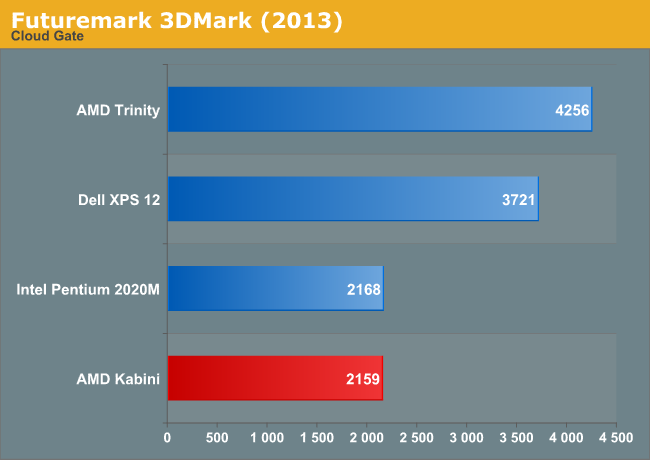
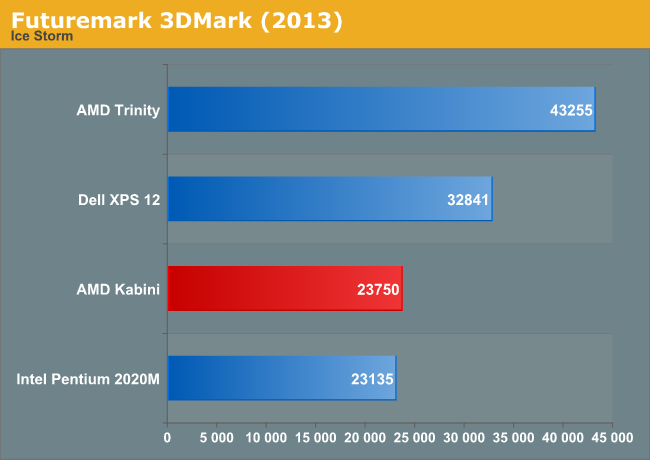
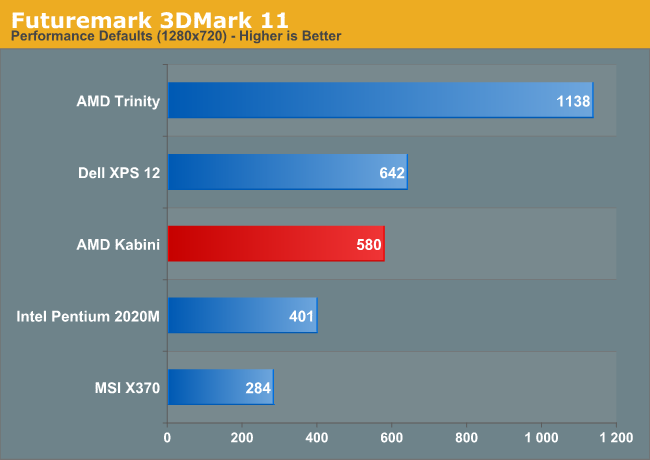
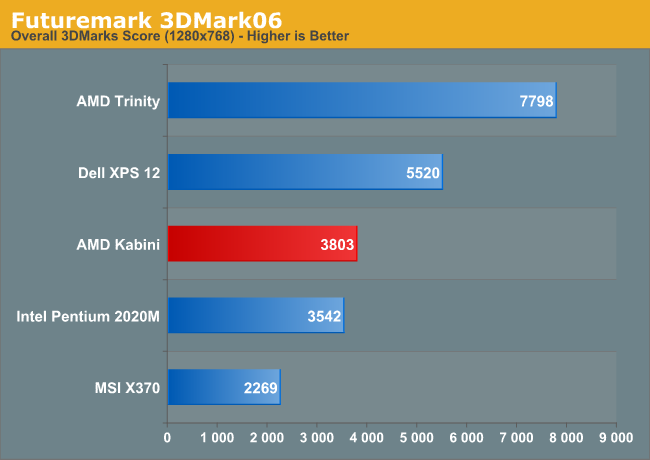
Quickly looking at the 3DMark results, if you were hoping Kabini would be fast enough to handle modern games at moderate detail settings, the relative standings in 3DMark should help prep you for what’s to come. The A10 Trinity can handle many titles at moderate details, but even it struggles with many of the latest releases; Kabini has about a third of the total GPU compute performance of Trinity, and while it’s a bit faster than that in some games, for the most part it’s best suited for older games that don’t require as much from the CPU or GPU.
As for Intel's chips, while the Core i7 ULV part ends up faster than Kabini, the same can't be said of the Pentium 2020M; it's a tie in some tests but falls behind (sometimes significantly, e.g. 3DMark 11) in others. As neither chip is really fit for high-end graphics work, it's not really a major concern. If you want decent graphics performance, you're going to want more than either Kabini or Ivy Bridge has to offer.










130 Comments
View All Comments
whyso - Thursday, May 23, 2013 - link
Because no one cares about Sandy Bridge ULV considering its now end of life. They also tested a lot of highly synthetic benchmarks. i3 ULV ivy notebooks can be had for $400 on newegg, i5 ULV notebooks cost $500 (http://www.newegg.com/Product/Product.aspx?Item=N8... sale yes but sales happen all the time). Also for the greater part of its lifetime, kabini will compete with haswell.Gaugamela - Thursday, May 23, 2013 - link
No, Kabini will compete with Pentiums. You guys keep forgeting that.And Ivy notebooks will be replaced and Kabini notebooks won't compete with them for most of it's shelf life. As for sales, do you think you won't see sales of Kabini notebooks?
Just because there's a small overlap of vendors clearing up inventory of Ivy notebooks doesn't invalidate that Kabini is a new chip and won't compete with Ivy Bridge for most of its life.
whyso - Thursday, May 23, 2013 - link
No, if an i5 ULV notebook costs $500, an i3 ULV notebook costs $400 and a kabini notebook costs $450 then the kabini is competing with i3/i5 and NOT pentium. Pricewise it competes with i3 and possibly i5. Haswell ULV will launch in a few months. Bobcat launched what? two years ago. With a similar lifetime (hope its shorter) jaguar will be competing with haswell for the vast majority of its lifetime.t.s - Thursday, May 23, 2013 - link
Yep. The barrier IMO, is OEM. OEM tend to hiking the price. When bobcat E350 first out, the average price is ~$360. What the hell. With $460, i can get 2x performance with sandy bridge i3.If only AMD want to build their own machine (laptop and desktop).
Gaugamela - Thursday, May 23, 2013 - link
A Kabini notebook costs 400$. And that's without having into account promotions, which WILL happen just as they happen to those precious i3 Ivy Bridges of yours. You seem to forget that promotions happen to all notebooks. And if you keep bringing ULV i3 Ivy Bridges for that price, then guess what? I'll get a TRINITY APU notebook instead for that price! Because I can also get them!! And they have a much stronger GPU power than Kabini, and Ivy Bridge and I can also get some quite decent ultrathins.whyso - Thursday, May 23, 2013 - link
Trinity and ivy bridge ULV are very similar in gpu performance. ULV ivy demolishes ULV trinity cpu wise though.Gaugamela - Friday, May 24, 2013 - link
The top Trinity LV APU (the A10-4655M) beats the Ivy Bridge ULVs in terms of GPU performance. The issue is that there's barely any notebooks for sale with it (The Samsung Series 5 ultrathin is one, the HP Sleekbook another).The A8-4455M is available in the Asus U38N and a Lenovo model and that one is weak. It's comparable to a Ivy Bridge i3 em terms of CPU/GPU performance (weaker single-thread but better multi-thread - more cores).
However, Trinity powered notebooks are usually cheaper than Ivy Bridge ones and you can get them with great promotions now.
whyso - Friday, May 24, 2013 - link
They are very similar and within error range (+/- around 10%).Gaugamela - Friday, May 24, 2013 - link
No, they're not. A A10-4655M with dual channel RAM beats the living crap of a HD4000. You just don't want to admit that. Go dig for benchmarks before spouting falsehoods.whyso - Friday, May 24, 2013 - link
No, mobile amd apus do very good in 3d mark but poorly in games because games have more cpu load (unlike 3dmark which is very cpu light) and the gpu can't boost as high. For instance the 7660G generally ties with the 630m in 3dmark but loses by about 20% in games. Thats a 25 watt part so it will do better than the 17 watt ULV but beat the living crap? NO. Even the 7660G only beats the HD4000 on average by 30%, move that down to ULV and the difference is less.